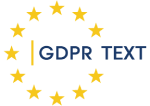Article 26 GDPR. Joint controllers
Article 26 GDPR. Joint controllers
1. Where two or more controllers jointly determine the purposes and means of processing, they shall be joint controllers. They shall in a transparent manner determine their respective responsibilities for compliance with the obligations under this Regulation, in particular as regards the exercising of the rights of the data subject and their respective duties to provide the information referred to in Articles 13 and 14, by means of an arrangement between them unless, and in so far as, the respective responsibilities of the controllers are determined by Union or Member State law to which the controllers are subject. The arrangement may designate a contact point for data subjects.
1. Where two or more controllers jointly determine the purposes and means of processing, they shall be joint controllers. They shall in a transparent manner determine their respective responsibilities for compliance with the obligations under this Regulation, in particular as regards the exercising of the rights of the data subject and their respective duties to provide the information referred to in Articles 13 and 14, by means of an arrangement between them unless, and in so far as, the respective responsibilities of the controllers are determined by Union or Member State law to which the controllers are subject. The arrangement may designate a contact point for data subjects.
2. The arrangement referred to in paragraph 1 shall duly reflect the respective roles and relationships of the joint controllers vis-à-vis the data subjects. The essence of the arrangement shall be made available to the data subject.
2. The arrangement referred to in paragraph 1 shall duly reflect the respective roles and relationships of the joint controllers vis-à-vis the data subjects. The essence of the arrangement shall be made available to the data subject.
3. Irrespective of the terms of the arrangement referred to in paragraph 1, the data subject may exercise his or her rights under this Regulation in respect of and against each of the controllers.
3. Irrespective of the terms of the arrangement referred to in paragraph 1, the data subject may exercise his or her rights under this Regulation in respect of and against each of the controllers.
The latest consolidated version of the Regulation with corrections by Corrigendum, OJ L 127, 23.5.2018, p. 2 ((EU) 2016/679). Source: EUR-lex.
The latest consolidated version of the Regulation with corrections by Corrigendum, OJ L 127, 23.5.2018, p. 2 ((EU) 2016/679). Source: EUR-lex.
(EN) ISO/IEC 27701, adopted in 2019, added additional ISO/IEC 27002 guidance for PII controllers.
Here is the relevant paragraph to articles 26(1), 26(2), and 26(3) GDPR:
7.2.7 Joint PII controller
Control
The organization should determine respective roles and responsibilities for the processing of PII (including PII protection and security requirements) with any joint PII controller.
Implementation guidance
Roles and responsibilities for the processing of PII should be determined in a transparent manner.
(EN) […]
(EN) Sign in
to read the full text
(79) The protection of the rights and freedoms of data subjects as well as the responsibility and liability of controllers and processors, also in relation to the monitoring by and measures of supervisory authorities, requires a clear allocation of the responsibilities under this Regulation, including where a controller determines the purposes and means of the processing jointly with other controllers or where a processing operation is carried out on behalf of a controller.
(79) The protection of the rights and freedoms of data subjects as well as the responsibility and liability of controllers and processors, also in relation to the monitoring by and measures of supervisory authorities, requires a clear allocation of the responsibilities under this Regulation, including where a controller determines the purposes and means of the processing jointly with other controllers or where a processing operation is carried out on behalf of a controller.
(EN)
Documents
Article 29 Working Party, Opinion 1/2010 on the concepts of „controller” and „processor” (2010).
EDPS, Guidelines on the Concepts of Controller, Processor and Joint Controllership Under Regulation (EU) 2018/1725 (2019).
EDPB, Guidelines 7/2020 on the Concepts of Controller and Processor in the GDPR (2021).
EDPB, Guidelines 8/2020 on the targeting of social media users (2020).
ICO, Right of Access (2020).
ICO, Data sharing: a code of practice (2020).
EDPB, Guidelines 02/2021 on Virtual Voice Assistants (2021).
Case Law
CJEU, Unabhängiges Landeszentrum für Datenschutz Schleswig-Holstein/Wirtschaftsakademie Schleswig-Holstein GmbH, C-210/16 (2018).
CJEU, Tietosuojavaltuutettu v Jehovan todistajat, C-25/17 (2018):
The existence of joint responsibility does not necessarily imply equal responsibility of the various operators involved in the processing of personal data. On the contrary, those operators may be involved at different stages of that processing of personal data and to different degrees, so that the level of responsibility of each of them must be assessed with regard to all the relevant circumstances of the particular case. Actual access to personal data is not a prerequisite for joint responsibility (p. 68-72).
CJEU, Fashion ID GmbH & Co. KG/Verbraucherzentrale NRW eV, C-40/17 (2019).

(EN) The expression “joint controller” is one of the most difficult to grasp in practice. It is nonetheless essential to delimit the role of the parties involved in the processing of personal data to determine their responsibilities under the General Data Protection Regulation (GDPR).
(EN) […]
(EN) Sign in
to read the full text